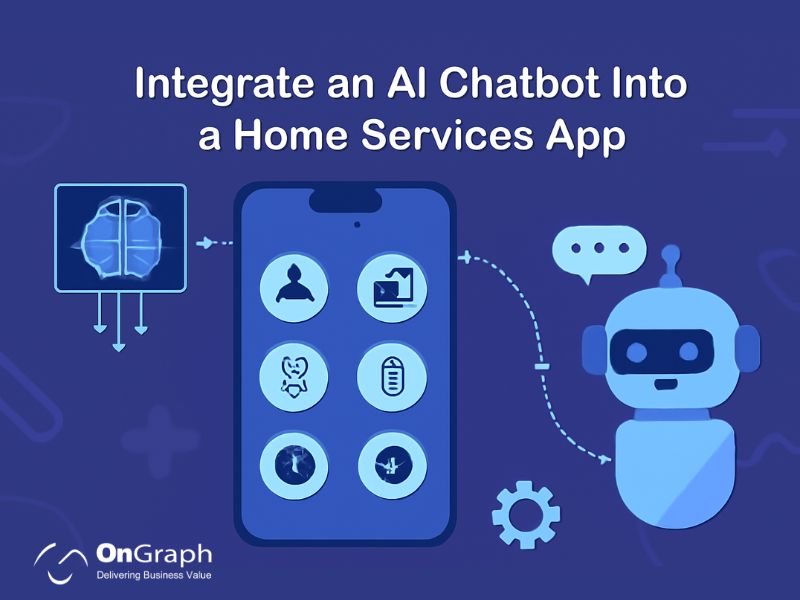In this article
- Why AI Chatbots Are Transforming the Home Services Industry?
- Understanding AI Chatbots for the Home Services Industry
- Core Benefits of Integrating AI Chatbots into Home Services Apps
- Key Use Cases for AI Chatbots in Home Services Apps
- How to Integrate AI Chatbots into a Home Services App
- Real Examples of Chatbot Usage in Home Services
- Cost of Integrating an AI Chatbot into a Home Services App
- Best Practices for AI-Powered Automation in Home Service Apps
- Conclusion
The demand for smarter, faster on-demand services has pushed businesses to integrate AI chatbot home services app solutions into their customer journeys.
Home services companies are adopting chatbots to automate bookings, manage leads, assist service providers, and improve customer satisfaction.
These automated assistants help users complete tasks faster and reduce operational costs for business owners.
A recent Salesforce survey shows that 69% of consumers prefer using chatbots for quick communication because they save time and offer instant responses.
Another 2024 industry report revealed that AI-driven automation can reduce customer service costs by up to 30%. For home services apps, these numbers highlight a huge opportunity.
This article explains how to integrate AI chatbot home services app systems effectively using real examples, practical strategies, and modern automation practices.
Why AI Chatbots Are Transforming the Home Services Industry?
Consumers expect faster service. They want instant quotes, immediate technician availability, and transparent communication. Chatbots help businesses deliver all three.
A well-implemented chatbot improves:
- Booking speed
- Lead capture
- Customer retention
- Provider support
- Response time
- Overall service quality
Let’s explore this transformation in detail.
Understanding AI Chatbots for the Home Services Industry
AI chatbots are virtual assistants built to provide quick, automated responses to user queries. They streamline communication between customers, service providers, and support teams.
Key capabilities include:
- Booking appointments
- Tracking service status
- Answering FAQs
- Offering personalized suggestions
- Managing complaints
- Assisting service providers
Most companies now want to integrate AI chatbot home services app tools because they support end-to-end service automation without increasing manpower.
Core Benefits of Integrating AI Chatbots into Home Services Apps
Home services businesses adopt chatbots for speed, accuracy, and customer satisfaction. Here are some major benefits.
1. Faster Response Times
Customers hate waiting. AI chatbots enable Chatbot booking automation, making the process quicker, smoother, and available 24/7.
A consumer study from 2024 showed that 42% of users expect responses within a minute from service apps. Chatbots meet this expectation easily.
2. Better Lead Generation and Higher Conversions
A Lead generation chatbot home services workflow captures leads even when your team is unavailable.
Chatbots help:
- Qualify users
- Recommend services
- Offer discounts
- Collect contact details
- Book instantly
Lead conversion increases because chatbots never miss an inquiry.
3. Automated Booking and Scheduling
Chatbot booking automation ensures instant appointment confirmation. Customers follow a simple conversation flow and complete a booking without calling a support team.
Chatbots reduce friction in:
- Selecting services
- Choosing time slots
- Adding location details
- Requesting service professionals
4. Lower Operational Costs
AI chatbots reduce dependency on support staff. A 2024 McKinsey report showed that automation can cut operational workload by 40%.
For a home services app handling thousands of messages daily, cost savings become significant.
5. Enhanced Customer Support
Chatbots offer quick answers to:
- Service availability
- Pricing
- Technician ETA
- Order status
- Refund policies
They improve satisfaction and reduce escalations.
6. Support for Service Providers
A Virtual assistant home services chatbot helps providers by sharing:
- New bookings
- Route details
- Customer notes
- Payment updates
- Instructions for service delivery
Techs stay updated in real time without manually checking the app.
Key Use Cases for AI Chatbots in Home Services Apps
Here are the most effective integrations businesses use today.
1. Service Discovery and Recommendations
Customers often struggle to identify the right service. Chatbots guide users by asking:
- What issue they are facing
- What appliance or material is involved
- When they need support
This improves accuracy and reduces misunderstandings.
2. Automated Booking Flow
A conversational interface completes bookings faster than traditional forms.
Users can:
- Choose services
- Confirm time
- View technician details
- Make secure payments
This automated flow boosts revenue.
3. Real-Time Order Tracking
Chatbots provide updates such as:
- Technician assigned
- Technician en route
- Service completed
- Payment processed
This reduces customer anxiety.
4. FAQ Handling
Most queries are repetitive. Chatbots handle:
- Pricing
- Availability
- Offers
- Refund timelines
- Cancellation rules
This frees human agents.
5. Complaint Management
Chatbots collect details and raise support tickets instantly. Complaints are logged in a structured flow, improving SLAs and customer satisfaction.
6. Lead Capture from Ads, Website, WhatsApp
Many businesses lose leads due to delayed responses. Integrating AI agents across WhatsApp and landing pages increases conversions through instant engagement.
7. Upselling and Cross-Selling
Chatbots highlight:
- Recommended add-on services
- Premium packages
- Membership plans
This increases average order value.
How to Integrate AI Chatbots into a Home Services App
Businesses often work with a White-label Home Services App Development Company when they need chatbot integration. Here is how the process works.
1. Identify the Automation Goals
Define the problems you want to solve:
- Reduce workload
- Improve booking speed
- Boost lead conversions
- Increase customer satisfaction
- Provide better provider support
2. Choose the Right Type of Chatbot
There are three main types.
a. Rule-Based Chatbot: Uses predefined flows. Good for simple FAQs.
b. NLP Chatbot: Understands natural language. Ideal for booking and recommendations.
c. Voice-enabled AI Agent: Helps users through spoken commands. Great for hands-free devices.
Most businesses prefer NLP chatbots for home services.
3. Back-End Integrations
Your chatbot must sync with:
- Booking system
- Calendar
- Payment gateway
- Technician dispatch system
- Rating and review module
- Notification engine
This ensures smooth automation inside the app.
4. Integration With Admin Panel
Your admin should control:
- Chatbot responses
- Offers
- Workflow rules
- Service listings
Modern White-label Home Services App Development Services offer easy panel control.
5. Connect Chatbot With WhatsApp, Web & Mobile App
Omnichannel support ensures you never miss a lead.
6. Testing & Optimization
Test for:
- Accuracy
- Speed
- UX
- Error handling
- Booking data flow
A refined chatbot improves conversions and customer satisfaction.
Real Examples of Chatbot Usage in Home Services
Case Example 1: Booking Automation
A cleaning service implemented Chatbot booking automation and reduced manual booking workload by 60%.
Case Example 2: Instant Lead Qualification
A plumbing service increased conversions by 37% using a Lead generation chatbot for home services ads.
Case Example 3: Service Provider Assistance
An electrician marketplace improved provider punctuality by 22% through real-time chatbot alerts.
These examples show how powerful chatbots are for operational efficiency.
Cost of Integrating an AI Chatbot into a Home Services App
The overall cost depends on:
- Features
- Integrations
- Complexity
- Type of chatbot
- API requirements
Most White-label Home Services App Development Company providers offer:
- Basic chatbot: $400–$900
- Advanced NLP chatbot: $1,000–$2,500
- Voice assistant: $2,000–$4,500
If your project already includes the app, then the added cost is much lower.
For businesses wanting complete solutions, a Home Service App Development Guide and cost breakdown helps in planning. Many factors overlap with your overall Home Service App Development Cost.
Best Practices for AI-Powered Automation in Home Service Apps
1. Keep the chatbot simple
Users prefer quick answers.
2. Train the chatbot using real scenarios
Use sample tickets and customer queries.
3. Offer an easy “Talk to Human” option
This increases trust.
4. Personalize user flows
Show relevant service suggestions.
5. Add clear CTAs
Encourage instant bookings.
6. Ensure data security and compliance
Protect personal information.
7. Keep updating the AI model
Improve accuracy and user satisfaction.
Following these practices helps businesses implement AI-Powered Automation Home Service Apps effectively.
Conclusion
Chatbots are becoming essential for modern home services apps. Businesses that integrate AI chatbot home services app systems can automate bookings, capture more leads, reduce costs, and improve operations. With rising competition in the on-demand market, automation is no longer optional.
Whether you want instant booking support, WhatsApp automation, or full conversational flows, AI chatbots are the fastest way to deliver better user experiences. Partnering with a trusted White-label Home Services App Development Company ensures a smooth, secure, and scalable integration.
FAQs
You can integrate a chatbot using APIs that connect your booking, payment, and notification modules. A developer sets up the logic, tests the flows, and deploys the chatbot inside your app, admin panel, and website.
It speeds up the process by avoiding manual steps. Users complete their booking in seconds through guided conversation. It reduces errors and increases service accuracy.
Yes. It captures user information instantly, provides quick answers, suggests services, and encourages immediate bookings. This increases lead quality and reduces drop-offs.
Cleaning, beauty services, plumbing, electrical repairs, AC maintenance, pest control, appliance repair, and painting. Any on-demand service can use chatbot automation.
Basic chatbots cost $400–$900. Advanced conversational agents cost $1,000–$4,500 depending on complexity, API requirements, and automation needed.
Yes. It shares booking updates, schedules, payment details, navigation routes, and job notes. Providers get quick support, improving punctuality and efficiency.
Yes. Chatbots reduce backend support load and manual staff expenses. They automate workflows, making long-term operations more affordable.
About the Author
Let’s Create Something Great Together!
Latest Blog















